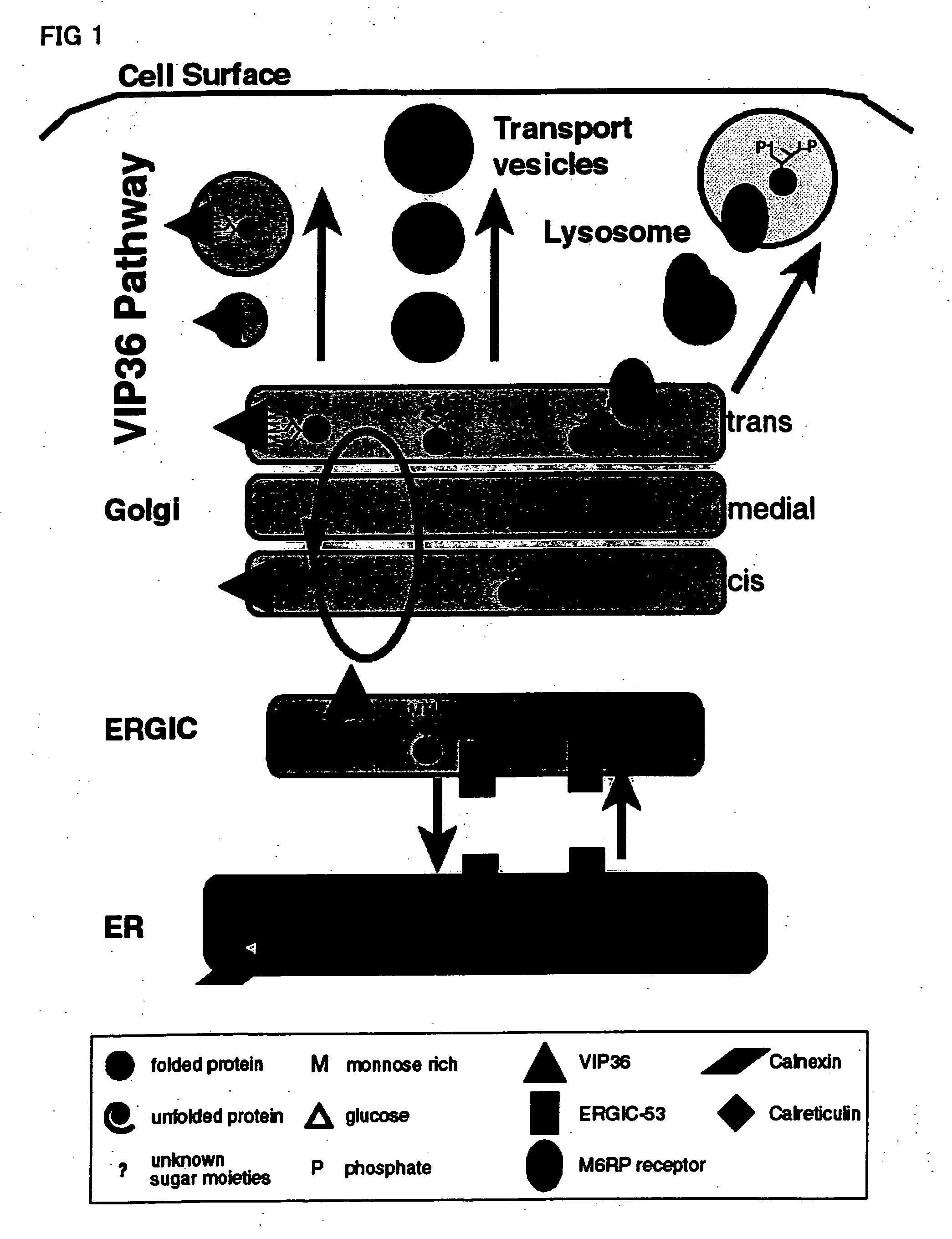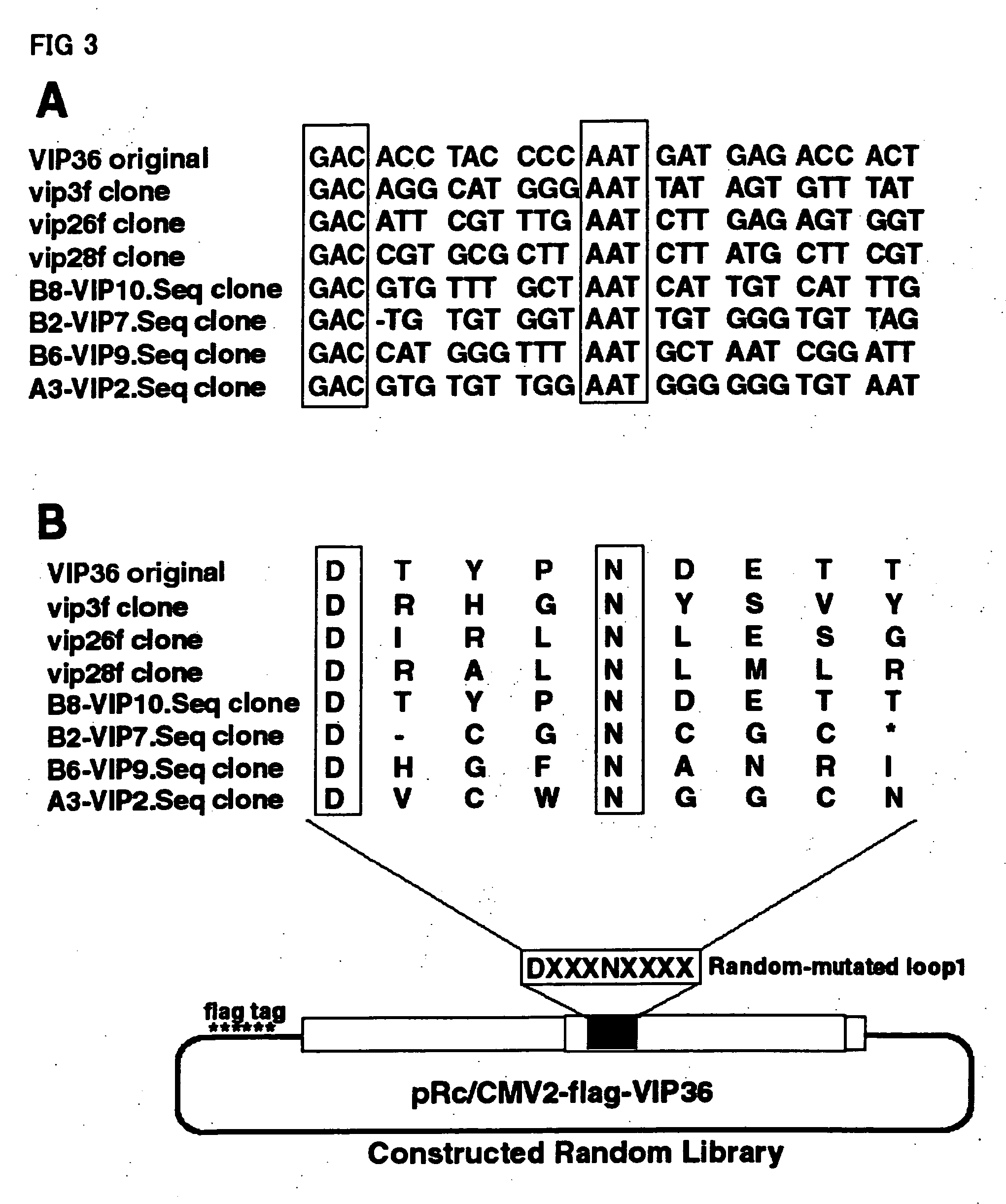Sugar chain library constructed via cargo receptor gene modification
a technology of cargo receptor and gene modification, which is applied in the direction of sugar derivates, animal/human proteins, peptides, etc., can solve the problems of insufficient technology for specifying and controlling the inability of genome studies or proteome studies to achieve direct glycosylation control, and the inability to specify and control the carbohydrate structure of glycoproteins. achieve the effect of easy and rapid
- Summary
- Abstract
- Description
- Claims
- Application Information
AI Technical Summary
Benefits of technology
Problems solved by technology
Method used
Image
Examples
example 1
Construction of VIP36 Random Library
(1) Plasmid pRc / CMV2-flag-VIPh-AflII
[0140] In this example, in order to introduce random mutations into a portion of cDNA encoding a carbohydrate-binding domain of VIP36, the following primers were designed with randomised oligonucleotides, overlapping cDNA encoding the carbohydrate-binding domain so that when polymerase chain reaction (PCR) was performed, the amplified cDNA fragments (named VIPt, nucleotide from 481 to 1071 of total size of 1407 nucleotides) contain randomly mutated carbohydrate-binding domain.
[0141] The following four primers were used for constructing VIP36 random library (FIG. 2A): VIPran1: 5′-GCA TGT CGA CAT AAC TGA CGG CAA CAG TG-3′ (SEQ ID NO: 5; with restriction site HincII: GTC GAC included at 5′ end of nucleotides), VIPran2: 5′-GAG CTC TAG AAA GAT GGC TAA GCC GTG GAA-3′ (SEQ ID NO: 6; with XbaI site: TCT AGA at 5′ end), VIPran3: 5′-CGT GCT CTA GAC NNK NNK NNK AAT NNK NNK NNK NNK GAG CGC GTG TTC CCG TA-3′, SEQ ID NO: ...
example 2
Transfection Into Cells
(1) Stable Transfection by Effectene™
[0156] Because VIP36 library constructed in Example 1 was stored in thirty two 1.5 ml tubes, plasmids in 117.4 μl of TE buffer was first prepared by combining portions of library solutions separately stored in thirty two independent pools. Ratio of solutions mixed was determined according to the size of independent clones including in library of each pool. This calculation was to keep equal of the diversity of randomised carbohydrate recognition domain (CRD). In detail, 2.5 μl (0.5 μl×5 tubes) was taken from library of the size being 500 clones, 5.4 μl (0.6 μl×9) from library of the size 6000 clones, 0.1 μl (0.1 μl×1) from library of the size 1000 clones, 1.0 μl (1 μl×1) from library of the size 1×104 clones, 66.0 μl (6 μl×11) from library of the size 6×104 clones, 1.5 μl (1.5 μl×1) from library of the size 1.5×104 clones, and 32.0 μl (8 μl×4) from library of the size 8×104 clones.
[0157] The plasmid prepared as above (na...
example 3
Carbohydrate Moiety-Based Separation of Transfected Cells
(1) Plant Lectins
[0165] Several plant lectins were used to separate transfected MDCK cells according to particular structure of oligosaccharides displayed on the cell surface. 10 kinds of lectins were used to distinguish a variety of oligosaccharides. Carbohydrate-binding specificity of lectins used were precisely analysed as shown in Table 1.
[0166] Biotinylated lectins (Honen Co.) were chosen so that lectin-bound cells could be recognised by Streptavidin MicroBeads (Miltenyi Biotec, colloidal paramagnetic MicroBeads conjugated to streptavidin). Lectins used were ABA lectin, ConA lectin, DSA lectin, LCA lectin, Lotus lectin, MAM lectin, Phaseolus vulgaris lectin with homotetrameric E-subunits (PHA-E4), Phaseolus vulgaris lectin with homotetrameric L-subunits (PHA-L4), RCA120 lectin, and WGA lectin. These lectins were selected among others because most of them were known to recognise N-linked and O-linked oligosaccharides. ...
PUM
| Property | Measurement | Unit |
|---|---|---|
| temperature | aaaaa | aaaaa |
| concentration | aaaaa | aaaaa |
| concentration | aaaaa | aaaaa |
Abstract
Description
Claims
Application Information
 Login to View More
Login to View More - R&D
- Intellectual Property
- Life Sciences
- Materials
- Tech Scout
- Unparalleled Data Quality
- Higher Quality Content
- 60% Fewer Hallucinations
Browse by: Latest US Patents, China's latest patents, Technical Efficacy Thesaurus, Application Domain, Technology Topic, Popular Technical Reports.
© 2025 PatSnap. All rights reserved.Legal|Privacy policy|Modern Slavery Act Transparency Statement|Sitemap|About US| Contact US: help@patsnap.com



